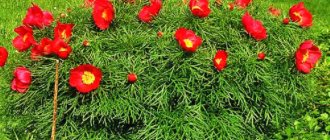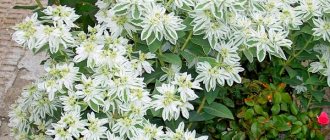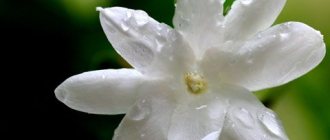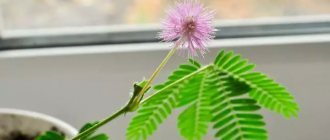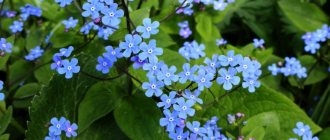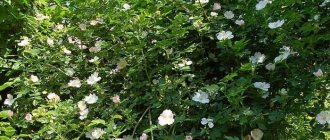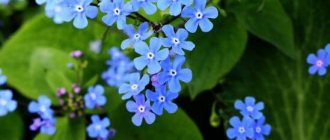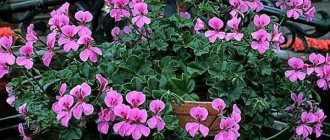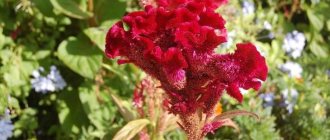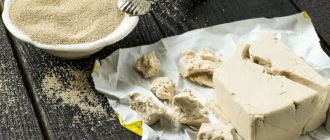Alpine forget-me-not and other species
Among the people, the flower is often also called “prigozhitsa” or “grolyanka”. It looks inconspicuous: bushes from 10 to 40 cm in height with highly branched stems and many sessile leaves crowned with small inflorescences-corymbs. The flowers of garden varieties are small (but much larger than wild ones), usually 5-7 mm in diameter, blue, pink or white with a bright yellow core, like the sun.
Flowering begins in the first third of summer and ends in July. Uncultivated species continue to open their buds until cold weather.
A representative of the Borachnikov family is grown as a one-, two-, or perennial. But by the end of the third season, the plant’s stems become excessively elongated and the number of flowers decreases. Plantings are rejuvenated by removing old ones and sowing a new generation.
Scientists count more than 50 species of forget-me-nots, growing in all corners of the Earth where there is a lot of moisture, sometimes in swamps. The most common among gardeners are:
- Alpine, living in the middle mountains of the Caucasus, in the Carpathians, Alps, Altai, and the south of the Urals. The height of the plant is about 15 cm, its petals are a rich dark blue color, and the leaves are light green. In bright light, flowering time is about 2 months. In the gardens of the lowland part of Russia, a specially bred garden variety is grown. Gardeners are popular with tall dark blue Music, 15-centimeter Indigo, dwarf pink Rosilva, and soft blue lush little Victoria.
- Swampy, grows wild along the edges of swamps and ponds. The species is distinguished by large flowers - up to 12 mm in diameter, and very long stems. The color of the corolla is blue or pink. The Thuringen variety is valued for its dark blue, almost blue flowers.
- Field, growing in almost all open places where the soil retains moisture for a long time. The stems are of medium height, the petals are small and blue.
- Forest, lover of shady thickets. A tall plant that blooms profusely with pink, blue or light blue flowers. The varieties Miro, Roggli, and Magnum series are popular.
- Arranged-flowered, native to Switzerland. Large corollas bloom profusely on 30-centimeter spreading stems. The Blau Grasmuk variety is common among domestic flower growers.
In the gardens there are also cultivated forms of fragrant forget-me-not, Sakhalin, Lazistan, pleasant and some other species.
Hybrid varieties are the results of the work of breeders. The color of the petals, depending on the variety, ranges from delicate to deep blue.
Botanical description of the plant
Description of forest forget-me-not:
- size - height up to 0.4 m;
- family - Borage;
- leaves - basal leaves have an oval shape, growing on the stem - with villi, oblong, elongated;
- stem - spreading and branched, bright green;
- flower - diameter from 1 to 1.3 cm, collected in inflorescences of 3 to 5 pieces, light blue;
- fruit - in the form of a sharp black nut, size - up to 2 mm;
- plant lifespan is from 2 to 3 years;
- flowering - from late May to late June;
- soil - moist, light;
- insolation - shade, partial shade.
Planting forget-me-nots
Most varieties of Prigozhits prefer slightly shaded areas, some prefer full shade. The exception is field and alpine varieties, which actively bloom only in well-lit areas.
Flowers do not make any serious demands on the soil: moderately fertile soil with good aeration, stagnation of water is undesirable. Forget-me-nots are planted in the garden in one of two ways: directly with seeds in a flowerbed or with seedlings.
Spring sowing of seeds in open ground
When the soil warms up well, it is loosened and peat or humus is added. After 2-3 weeks, they dig it up again and level it.
Small holes are prepared for sowing at a distance of 10 cm from each other. The sown seeds are covered with a thin layer of soil and covered with polyethylene on top. Shoots appear after 2 weeks. Seedlings are thinned out to provide them with comfortable growing conditions.
Autumn sowing for seedlings
Conducted at the very beginning of winter. Seedling boxes are filled with a substrate of one third of washed river sand and two thirds of disinfected turf soil. The seeds are scattered over the surface of the soil, lightly pressed, and lightly sprinkled with soil.
Then the crops are moistened through a spray bottle. The first shoots appear by the end of the first week. When the first 2-3 true leaves are formed, the seedlings are transplanted into separate cups and placed in an unheated greenhouse until spring. When the snow melts, the cups with seedlings are transferred to a moderately warm room. Seedlings are planted in flower beds in April. On most plants, buds are already forming by this time.
Use in landscape design
The best choice would be group planting. They can accentuate the rest of the flowers in the garden or become an independent decoration. The choice of planting and the desired result depends on the specific plant variety. For example:
- For planting near an artificial pond or swimming pool, the swamp forget-me-not is best suited.
- For rosaries, you can choose flowers from hybrid varieties of Alpine forget-me-not.
- To transform the border, use a forest beauty.
- With the help of low-growing varieties you can create an unusually beautiful carpet.
Forget-me-not flower carpet
Hedge of forget-me-not flowers
Painting with forget-me-nots near the lake.
Forget-me-nots are also grown in pots, which are subsequently used to decorate balconies, terraces or window sills.
They go well with daisies, tulips, pansies and ferns.
Conditions for growing forget-me-nots
Grolyanka is unpretentious and does not require special conditions. A sufficient amount of light and shade, moderate watering, rare fertilizing, measures to protect against pests and diseases do not take much time and are accessible to beginning gardeners.
Watering
Irrigation is required 2 times a week for flowers growing in open sunny areas and alpine hills. Inhabitants of shady corners are watered once a week, provided there is no natural precipitation.
To reduce hassle, forget-me-nots are usually planted in the company of garden plants that reliably shade the soil.
Feeding
On overly fertile soil, the plant begins to fatten - to increase only the leaf mass. Therefore, fertilizers must be handled with extreme caution. During the season, it is enough to add peat or humus twice - in spring and autumn, and immediately after flowering, water with liquid mineral complexes.
Other care activities
Experienced gardeners recommend loosening the soil regularly, at least once every 10-15 days, so that nutrients and oxygen can easily reach the roots.
The flowers do not need weeding - the powerful root system drowns out the weeds trying to get out of the ground.
There is no need to prepare flowers for winter. The roots tolerate severe frosts well even without snow cover. Sometimes gardeners simply mulch their plantings with a thin layer of dry leaves.
Reproduction of forget-me-nots
All traditional methods are suitable for propagation: using seeds, cuttings, dividing the bush.
Seeds
Collected as they ripen. After drying, they are poured into a fabric bag and stored until sowing, but not more than 3 years. You can immediately sow fresh seeds in flower beds and flower beds. However, it should be remembered that hybrid forms of forget-me-nots do not transmit varietal characteristics if they are propagated in this way.
Sometimes summer residents don’t even bother collecting seeds - the plant grows well by self-sowing. In spring, young bushes are carefully dug up and planted in the right place.
Dividing the bush
The optimal way to increase the number of hybrid forms. The procedure can be carried out at any warm time of the year; the hardy root system tolerates division without damage and easily takes root in a new place.
The bushes are dug up and carefully divided into several parts. Each division is planted in a prepared hole.
Cuttings
Also used for propagation of hybrid and varietal highly decorative forget-me-nots. At the end of flowering, cut the apical shoots with a sharp, disinfected knife. Plant them immediately and cover them with polyethylene or transparent glass containers. Watering is carried out very carefully: water on the leaves is extremely harmful to cuttings. To make the bushes branch, they are pinched 1-2 cm.
With this method of propagation, blueberries bloom in the same year. But for the winter they need to be covered with spruce branches or agrofibre.
Application
When looking at a photo of a forget-me-not, note for yourself the fact that the plant has several variations of use. Next, we invite you to familiarize yourself with some of the most popular ways to use flowers in everyday life.
In medicine
Forget-me-not is not officially used in any medical preparation, but it has found more than widespread use in folk formulations. With its help, you can cope with a large number of skin diseases, as well as prevent blood loss from a deep wound.
In beekeeping
Field forget-me-not is an excellent perganos and honey plant. Often this is what beekeepers plant near their hives.
In aromatherapy
Forget-me-not oil is produced, which contains a large amount of potassium. This oil is subsequently prescribed for use by people with potassium deficiency. The oil helps combat the effects of paralysis, hypotension and asthenia.
Forget-me-not pests and diseases
Flowers are highly resistant to disease. The only cause of damage can be excessive watering.
Waterlogged soil is a favorable environment for the development of fungal infections - powdery mildew, root rot, gray rot. If signs of disease appear on the leaves and stems, treat with any fungicide (copper sulfate, HOM, Skor, Fitosporin and others).
To prevent an outbreak of infection, monitor planting density and thin out plants in a timely manner. Also avoid drying out the soil or prolonged stagnation of moisture under the flowers.
Pests also do not actively attack forget-me-nots, which makes caring for them much easier. Insecticides are used only when parasites are detected or in the event of a massive invasion of the area.
Benefit
When looking at forget-me-not flowers, photos of which are presented in high resolution below, be sure to pay attention to their beneficial properties. With proper preparation of decoctions and rubs, forget-me-not will help you:
- cope with inflammation;
- stop the bleeding;
- cause expectorant action;
- reduce sweating;
- neutralize itching;
- remove swelling;
- cure skin rashes and eczema;
- remove the tumor.
